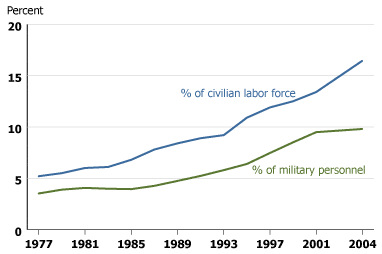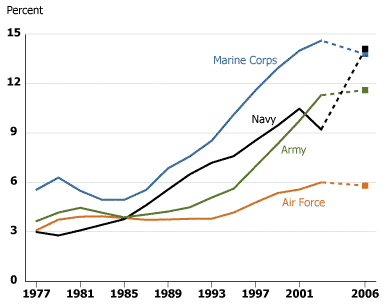
Latinos Claim Larger Share of U.S. Military Personnel
More than 35 million Americans identify as Hispanic, making them the country’s largest ethnic minority. However, Latinos have been underrepresented in the all-volunteer armed forces, especially among officers.
This is beginning to change, as increasing numbers of Hispanics enter the military. Moreover, despite the traditionally masculine culture of the military and of Hispanics, the Hispanic share of military women has been increasing faster than the Hispanic share of military men.1
The past 20 years have witnessed dramatic increases in the percentage of Latinos (of both sexes) among active duty enlisted personnel (see Figure 1).
Figure 1
Hispanics in the U.S. Civilian Labor Force and Military Services, 1997 to 2004

Note: Percent of men and women ages 18-44.
Source: Department of Defense, Population Representation in the Military Services, Fiscal Year 2004.
The increase in Latinos in the military has not quite kept pace with their rise among 18-to-44-year-olds in the civilian labor force. Latinos made up 16 percent of the civilian labor force in 2004, but less than 10 percent of enlisted personnel and 13 percent in September 2006.2 However, the civilian figure includes those who do not meet military requirements for enlistment, including education and immigration status. Until recently, enlistment required a high school degree. Almost all (99 percent) of enlisted personnel in Fiscal Year (FY) 2001 (Oct. 1 to Sept. 30) had either a high school degree or the equivalent, such as a General Education Development (GED) certificate. Also, until recently, immigrants had to be citizens or legal permanent residents to enlist. Under these qualifications, Latinos actually have been overrepresented among enlisted personnel. In FY 2001, Latinos made up 8.2 percent of the qualified civilian work force and 9.5 percent of enlisted service members.3
Navy, Marine Corps Are Top Choices
Latinos’ representation has been highest in the Marine Corps and lowest in the Air Force. In FY 2004, nearly 15 percent of U.S. Marine Corps enlisted personnel were Hispanic, compared with 6 percent of Air Force enlisted personnel. Latino representation in the Navy has been rising. By September 2006, they constituted 14 percent of Navy enlisted personnel, about the same as in the Marine Corps that year (see Figure 2).
Figure 2
Hispanic Share in the Four Branches of the U.S. Military, 1997 to 2006

Note: These figures were for the fiscal years (Oct. 1 to Sept. 30). No estimates were available for 2005.
Source: Department of Defense, Population Representation in the Military Services, Fiscal Year 2004; and data provided by the Office of the Deputy Under Secretary of Defense (Equal Opportunity).
Latino men used to constitute a larger percentage of enlisted men than Latinas did of enlisted women. However, this has changed: Latinas have caught up and even slightly surpassed Latinos in their gender’s representation in the military (see table).
Percent of Active Duty Personnel Who Are Latino, by Rank and Sex, Sept. 30, 2006
|
Rank
|
Men (%)
|
Women (%) |
Total (%)
|
|---|---|---|---|
|
Officers
|
|||
|
O7-O11
|
1.3
|
2.0
|
1.3
|
|
O4-O6
|
3.9
|
4.1
|
3.9
|
| O1-O3 |
5.6
|
5.9
|
5.6
|
|
Total Officer
|
4.8
|
5.3
|
4.9
|
|
Warrent Officer
|
6.7
|
8.6
|
6.9
|
|
Enlisted Personnel
|
|||
|
E7-E9
|
7.7
|
6.4
|
7.5
|
|
E5-E6
|
11.4
|
11.7
|
11.4
|
|
E1-E4
|
11.6
|
13.4
|
11.9
|
|
Total Enlisted
|
11.0
|
12.2
|
11.2
|
Source: Constructed from data provided by the Office of the Deputy Under Secretary of Defense (Personnel and Readiness).
As of September 2006, Hispanic men accounted for 11 percent of enlisted men and Hispanic women were 12 percent of enlisted women. The Hispanic share of commissioned officers is much lower: 4.8 percent for men and 5.3 percent for women—with a slight edge for Latinas. This is surprising given the traditionally masculine culture of the armed forces and the traditionally feminine, home-based role for Latinas.
Latinos in the Reserves and National Guard
Hispanic representation also has increased in the military Reserve Components, which have been more active in the current war in Iraq than at any time since World War II. These trends for the reserves mirror those in the active forces. Hispanic representation in the reserve enlisted force increased from 7.7 percent in 1999 to 9.2 percent in 2005. Similarly, Latino reserve recruitment increased from about 7.5 percent in 1999 to about 9.5 percent in 2002, although it subsequently declined slightly.
Hispanics are more heavily represented in the federal reserves (Army, Naval, Air Force, and Marine Corps Reserves) than in the state-based Army or Air National Guard. Among the federal forces, they are more heavily in the sea services (Naval Reserve and Marine Corps Reserve) than in the ground combat forces. Indeed, as the Marines have been increasingly involved in ground combat operations in Iraq, the share of Hispanic recruits going into the Marine Corps Reserve has declined, from the 2001 figure of more than 14 percent of recruits with no prior service to fewer than 6 percent in 2004. Hispanic representation in the enlisted ranks of the Marine Corps Reserve peaked in 2002 at 15.4 percent. Hispanic representation and recruitment have been consistently lower in the Air National Guard than the Army National Guard, and lower in the Air Force Reserve than in the other federal reserve forces.
Latinas have been gaining ground compared with Latinos. Since 2001, Latinas have accounted for a greater—and increasing—share of reserve recruits.
While Latinos are still underrepresented among military personnel, given their share of the U.S. population, they are overrepresented among enlisted personnel considering their lower educational attainment and their naturalization status. The military services may be recruiting more Latinos partly to help defray the declines in African American recruits.4
Further Increases Likely
Besides the rapid increase in the U.S. Hispanic population, Latinos are likely to increase in the military because of several recent trends and activities. The Army has launched a vast recruiting campaign targeting Latino youth, placing ads in Spanish-language media, including magazines, radio, and television. The number of Hispanic Army enlistments rose 26 percent between 2001 and 2005.5
The various recruitment efforts do have critics, both within and outside the Hispanic community, particularly during this time of war and a growing number of reported Hispanic casualties.6 Nevertheless, research shows that there is widespread support for military service within the Hispanic community.7 The propensity to serve in the military (generally measured by the desires of young people to consider the military as one of their first choices of activities—especially in the Marine Corps—is high among Latinos.8 Hispanics are more likely to complete boot camp, finish their military service, and to reenlist than any other group of Marines.9
Latinas and Latinos are more highly represented among enlisted personnel in the Marine Corps than in the other services. There are several possible reasons why. One is the Marine Corps’ successful marketing—using Hispanic recruiters—in Hispanic areas. Another possible reason is that the Marine Corps culture appeals to Hispanic values. Given the high representation of Latinas, it is clearly not just the macho image of the Marine Corps that appeals to Hispanics.
Hispanics in the Army—a rather diverse group—are largely immigrants or the children of immigrants. One study of 1,191 active-duty Army personnel showed just 39 percent of Hispanic respondents were born in the United States to U.S.-born parents.10 Hispanics are also more likely than non-Hispanic whites in the Army to report coming from working-class families rather than middle- or upper-class families, and to come from large urban areas.
If the current recruiting and re-enlistment trends continue, Hispanic men and women continue to increase their presence in the U.S. military services.
Mady Wechsler Segal is Distinguished Scholar-Teacher, professor of sociology, associate director of the Center for Research on Military Organization, and faculty affiliate in the Women’s Studies Program and in the School of Public Policy at the University of Maryland, College Park. David R. Segal is Distinguished Scholar-Teacher, professor of sociology, director of the Center for Research on Military Organization, faculty associate in the Maryland Population Research Center, and faculty affiliate in the School of Public Policy at the University of Maryland, College Park.
This article is based on research supported by the U.S. Army Research Institute for the Behavioral and Social Sciences. The views expressed are those of the authors and not necessarily of the Army Research Institute, the Department of the Army, or the Department of Defense.
References
- We use the terms Latino and Hispanic interchangeably and intend them to include Chicanos. We use the term Latina to refer to Hispanic women and Latino to refer to men or both men and women (and it is clear in context). We also use the terms black and African American interchangeably.
- The latter two figures include enlisted personnel of all races who consider themselves Hispanic (the Department of Defence (DoD) now measures race and ethnicity with two separate survey questions. DoD used to ask service members to indicate their race and ethnicity with one item, so, for example, black Hispanics had to identify as one or the other, but not both. As of FY 2003, they are asked whether they are Hispanic or not in a question separate from the question about their race. Further, service members can choose more than one race.
- Pew Hispanic Center, Hispanics in the Military Fact Sheet (Washington, DC: Pew Hispanic Center, 2003), accessed online at www.pewhispanic.org, on Oct. 10, 2007.
- David R. Segal and Mady Wechsler Segal, “Army Recruitment Goals Endangered as Percent of African American Enlistees Declines” (2005), accessed online at www.prb.org, on Oct. 12, 2007.
- Lizette Alvarez, “Army Effort to Enlist Hispanics Draws Recruits, and Criticism,” The New York Times, Feb .9, 2006.
- Alvarez, “Army Effort to Enlist Hispanics Draws Recruits, and Criticism”; Brian Gifford, “Combat Casualties and Race: What Can We Learn From the 2003-2004 Iraq Conflict?” Armed Forces & Society 30, no. 2 (2005): 201-25; and Mary Ann Zehr, “Latinos Urged to Opt Out of Military Recruitment in Schools,” Education Week (Nov. 16, 2005): 125.
- Alvarez, “Army Effort to Enlist Hispanics Draws Recruits, and Criticism”; Gifford, “Combat Casualties and Race”; Zehr, “Latinos Urged to Opt Out”; and David L. Leal, “American Public Opinion Toward the Military: Differences by Race, Gender, and Class?” Armed Forces & Society 32, no. 1 (2005): 123-38.
- Jim Garamone, “Military Demographics Representative of America, Officials Say,” American Forces Information Service, Nov. 23, 2005.
- Anita U. Hattiangadi et al., Non-Citizens in Today’s Military: Final Report 2005 (Alexandria, VA: Center for Naval Analyses Corporation, 2005).
- Jason K. Dempsey and Robert Y. Shapiro, Citizenship and Service: The Attitudes and Experiences of Hispanic Soldiers in the United States Army (draft manuscript, 2005).
Additional articles on the U.S. military written by Mady Wechsler Segal and David R. Segal:
Army Recruitment Goals Endangered as Percent of African American Enlistees Declines
The past five years have seen a drop in overall African American enlistment levels that has reduced black participation in the armed forces to percentages not seen since 1973. (December 2005)
U.S. Military’s Reliance on the Reserves
As military reservists continue to constitute nearly 40 percent of the 150,000 U.S. forces now deployed in Iraq, debate continues to grow about the military’s current reliance on the reserves. (March 2005)
Population Bulletin: “America’s Military Population” (PDF: 672KB) (BUL 59.4; December 2004)
